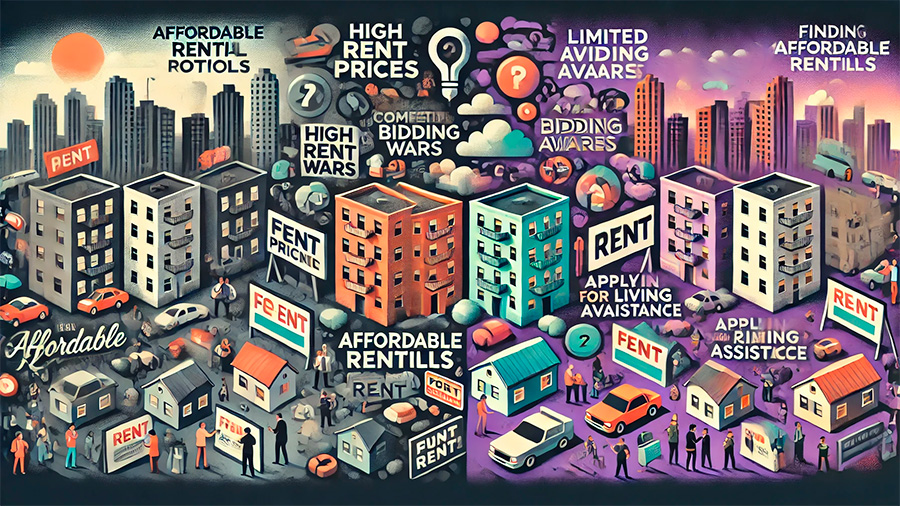In today’s increasingly competitive housing market, securing affordable housing has become a significant challenge for many individuals and families. Rising home prices, limited inventory, and high demand have created an environment where finding a home that fits your budget requires both strategy and flexibility. Despite these challenges, it is still possible to navigate the market effectively and find affordable housing. This article will provide insights into the current housing dynamics and offer practical strategies to help you secure an affordable home or rental property.
The Challenge of Finding Affordable Housing
The past few years have seen housing prices rise dramatically across many regions, driven by a mix of low interest rates, strong demand, and a shortage of available homes. This combination has led to steep competition, making it increasingly difficult for first-time homebuyers and renters to find affordable options.
With home prices continuing to climb, affordability has become a key issue for many prospective buyers. As housing costs rise faster than wages in many areas, it can be hard to keep up with the financial demands of purchasing a home. Furthermore, with fewer homes on the market, buyers often face bidding wars and the need to make fast, competitive offers. In some cases, potential buyers are forced to either adjust their expectations or expand their search beyond their desired areas.
In addition to price hikes, limited inventory adds another layer of difficulty. As fewer homes are available, the competition becomes more intense. In highly desirable locations, this scarcity often leads to higher prices, as buyers compete for the same limited number of properties. The shortage of homes not only drives up prices but also makes the overall home search more stressful and time-sensitive for many individuals.

Effective Strategies for Finding Affordable Housing
Despite these challenges, there are practical approaches you can take to increase your chances of finding affordable housing. By adjusting your expectations, broadening your search area, and taking advantage of available resources, you can better position yourself in a competitive market.
One key strategy is to expand your search beyond the most competitive areas. While urban centers may offer convenience and lifestyle appeal, they often come with higher price tags. By looking at less densely populated neighborhoods or suburban areas, you can find more affordable housing options. These areas may require a longer commute or a shift in lifestyle, but they can provide access to homes or rental properties that fit within your budget.
Another approach is to consider smaller homes, condos, or older properties that may be priced more affordably than newer or larger options. While these properties might require some upgrades or renovations, they can offer a more financially accessible entry point into the housing market. In many cases, choosing a smaller or older home allows you to invest in a property that has room for improvement over time without the upfront costs of a new build or a larger home in a prime location.
In addition, many states, local governments, and nonprofit organizations offer first-time homebuyer assistance programs that can help ease the financial burden of purchasing a home. These programs can provide down payment assistance, low-interest loans, or tax incentives, making homeownership more achievable for those on a tight budget. Taking advantage of these resources can significantly reduce the upfront costs of buying a home and make the overall process more affordable.
Being prepared to act quickly when you find an affordable property is also crucial. In a competitive market, homes and rental properties can be snapped up within days or even hours of being listed. Having your finances in order, including getting pre-approved for a mortgage, allows you to move quickly when the right opportunity arises. Preparation ensures that you can make a strong offer and secure a home before it’s taken by another buyer.
For those open to alternative financing options, shared equity programs or co-buying arrangements can provide additional pathways to homeownership. In a shared equity program, buyers receive financial assistance from a government or nonprofit entity in exchange for a share of the home’s future value. This type of arrangement lowers the initial purchase price and helps make homeownership more accessible. Co-buying, or purchasing a home with friends or family members, can also reduce the financial strain by allowing multiple parties to share the costs of the down payment and mortgage.

Affordable Rental Options in a Competitive Market
For individuals or families not ready to buy, renting can offer a more flexible and affordable housing option, especially in high-demand areas. However, like the home-buying market, rental properties have also become increasingly competitive, particularly in major cities. Rising rents and limited availability make finding affordable rentals challenging, but there are strategies that can help you secure a rental within your budget.
One option is to look for rent-controlled properties, where annual rent increases are limited by local laws. Rent control can provide stability in terms of predictable housing costs, making it easier to budget for long-term living expenses. While rent-controlled units can be harder to find in competitive markets, securing one can provide significant financial relief.
Another effective strategy is negotiating directly with landlords. In less competitive areas or during slower rental seasons, landlords may be more open to negotiation on rent or lease terms. Offering to sign a longer lease in exchange for a lower monthly rent, or requesting that certain fees be waived, can make a rental more affordable without compromising on quality or location.
For those seeking an even more affordable solution, sharing a home or renting a room in someone else’s property can reduce housing costs substantially. House-sharing arrangements allow multiple individuals to split rent and utility expenses, making living costs more manageable, especially in high-demand areas. This option is particularly appealing to students, young professionals, or those moving to a new city.
Government and Nonprofit Housing Assistance Programs
For individuals facing significant affordability challenges, there are housing assistance programs offered by government agencies and nonprofit organizations designed to help low- and moderate-income families. These programs can provide financial support or access to subsidized housing, making it easier to find affordable living arrangements.
Housing vouchers, such as those offered through the Section 8 program in the U.S., provide financial assistance to renters by covering a portion of their monthly rent. These vouchers make it possible for low-income individuals and families to afford rental properties in the private market while only paying a reduced amount based on their income.
Subsidized housing programs, such as those funded by the Low-Income Housing Tax Credit (LIHTC), offer rental units at below-market rates to individuals and families who meet specific income requirements. These programs ensure that those with lower incomes can access safe, affordable housing in areas where market-rate properties may be out of reach.
Conclusion: Navigating Affordable Housing in a Competitive Market
While finding affordable housing in today’s market may seem daunting, there are strategies that can help you succeed. By expanding your search area, considering smaller or older homes, exploring government assistance programs, and being prepared to act quickly, you can improve your chances of securing a home that fits your budget. For renters, exploring rent-controlled properties, negotiating with landlords, and considering house-sharing arrangements can offer more affordable solutions. With the right approach and resources, you can find a housing option that works for your financial situation, even in a highly competitive market.

